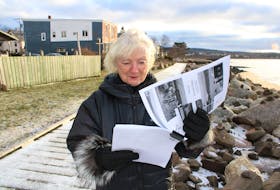FENWICK – Some might call him a scholar of syrup, but not Gordon Smith.
“I’ve just always loved working in the woods,” said Smith.
The 82-year-old says he has been venturing into sugar camps since he was two-years-old.
“On our old home farm, when I was a kid, we had a sugar woods. We used to go in with a horse and stay for the week,” said Smith. “As a kid, I used to go in quite often. We gathered a bucket at a time and put the sap in a wooden tub on a sled that the horse pulled.”
Smith has been a fixture in the local farming community his entire life, starting the Fort Equipment dealership in Amherst.
“We sold it in 1980,” said Smith.
Since 1996, Smith has worked each spring at the Donkin’s Maple Sugar Woods.
“I’m quality control. The taster I guess.”
He says syrup tastes different throughout Canada and, also, within Cumberland County.
“Most people claim it’s the way they make it but the truth of the matter is, it’s what’s in the ground. It’s what’s in the sap when it’s made where you get the different tastes,” said Smith. “We get a different taste here at Maccan Mountain than they do in Advocate and Westchester. It will all be a little different.”
He says the taste remains the same year-to-year but can change throughout a single season.
“You also get a different taste from early in the season to late in the season.”
A big part of Smith’s job is checking the thickness of the sap.
He controls the temperature of the sap throughout the entire boiling process and, most important, removes the sap from the evaporator when it turns into syrup.
“I check it manually quite often. We call it sheeting.”
Smith picks up a square, tin scoop, turns a valve and pours about one-fifth of a cup into the scoop. He then pours the scoop of syrup into a pot, looking for just the right consistency.
“When it sheets off, and hangs off there about half an inch, like ice coming off a tin roof, then I know it’s syrup,” said Smith.
Once it’s ready, he turns the valve wide open, letting the syrup flow into a large pot. Once full, he takes the pot and pours it into a second container with a cloth strainer inserted inside.
The syrup is then poured into a stainless-steel finishing tank.
“Syrup has to be exact or it won’t take. If it’s too thin it will turn sour, if it’s too thick it will crystalize too much,” said Smith. “If it’s done just right it will keep for a long time.”
He says some of the more modern operations pour the syrup automatically when it’s ready.
The Donkin Sugar Woods taps about 7,500 trees, and on good day’s it takes about 40 gallons of sap to make one gallon of syrup.
“When we started this year, it was probably an 80-to-1 ratio, but today I’d say it’s about 40-to-1,” said Smith. “We go through 100 gallons of sap an hour here when we’re going good.”
This year was the earliest start to the syrup season, Feb. 16.
By the end of the season at least 30-cord of wood will have been burned in the evaporator.
“Some days we’ll go through a cord of wood,” said Smith.
When the sap is flowing fast, Smith will work alongside about six other people at the camp and always enjoys meeting people who come to the camp, both newcomers and returnees.
“Just to be here with the fellas and meet all the people is great,” said Smith. “I always enjoy this time of the year.”








